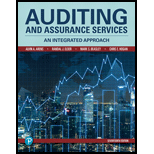
Auditing And Assurance Services
17th Edition
ISBN: 9780134897431
Author: ARENS, Alvin A.
Publisher: PEARSON
expand_more
expand_more
format_list_bulleted
Question
Chapter 6, Problem 29DQP
To determine
Describe the most likely judgement trap that ultimately biased the decision making of the auditor in the audit, for each of the scenarios.
Expert Solution & Answer
Want to see the full answer?
Check out a sample textbook solution
Students have asked these similar questions
Please explain the accurate process for solving this financial accounting question with proper principles.
I am trying to find the accurate solution to this general accounting problem with the correct explanation.
Can you help me solve this general accounting question using the correct accounting procedures?
Chapter 6 Solutions
Auditing And Assurance Services
Ch. 6 - Prob. 1RQCh. 6 - Prob. 2RQCh. 6 - Prob. 3RQCh. 6 - Prob. 4RQCh. 6 - Prob. 5RQCh. 6 - Prob. 6RQCh. 6 - Prob. 7RQCh. 6 - What are the six elements of professional...Ch. 6 - What are the five elements of an effective...Ch. 6 - Describe two of the more common judgment traps and...
Ch. 6 - Identify the cycle to which each of the following...Ch. 6 - Why are sales, sales returns and allowances, bad...Ch. 6 - Prob. 13RQCh. 6 - Prob. 14RQCh. 6 - Prob. 15RQCh. 6 - Prob. 16RQCh. 6 - Prob. 17RQCh. 6 - Prob. 18RQCh. 6 - Prob. 19RQCh. 6 - Prob. 20RQCh. 6 - Prob. 21.1MCQCh. 6 - Prob. 21.2MCQCh. 6 - Prob. 21.3MCQCh. 6 - Prob. 22.1MCQCh. 6 - Prob. 22.2MCQCh. 6 - Prob. 22.3MCQCh. 6 - Prob. 23.1MCQCh. 6 - Prob. 23.2MCQCh. 6 - Prob. 23.3MCQCh. 6 - Prob. 24.1MCQCh. 6 - Prob. 24.2MCQCh. 6 - Prob. 24.3MCQCh. 6 - Prob. 25DQPCh. 6 - Prob. 26DQPCh. 6 - Prob. 27DQPCh. 6 - Prob. 28DQPCh. 6 - Prob. 29DQPCh. 6 - Prob. 30DQPCh. 6 - Prob. 31DQPCh. 6 - Prob. 32DQPCh. 6 - Prob. 33DQPCh. 6 - Prob. 34DQP
Knowledge Booster
Similar questions
- I am searching for the most suitable approach to this financial accounting problem with valid standards.arrow_forwardPlease solve this General accounting questions step by steparrow_forwardPremier Utilities Group Company's revenue for April is $92,000, but only $22,000 cash is collected. Expenses for April are $53,000, of which $37,000 is paid in cash. During April, additional capital stock is issued in exchange for $8,000 cash. Using the accrual basis of accounting, what would Premier Utilities Group Company's income statement for April report? Need answerarrow_forward
arrow_back_ios
SEE MORE QUESTIONS
arrow_forward_ios
Recommended textbooks for you
 Auditing: A Risk Based-Approach (MindTap Course L...AccountingISBN:9781337619455Author:Karla M Johnstone, Audrey A. Gramling, Larry E. RittenbergPublisher:Cengage Learning
Auditing: A Risk Based-Approach (MindTap Course L...AccountingISBN:9781337619455Author:Karla M Johnstone, Audrey A. Gramling, Larry E. RittenbergPublisher:Cengage Learning Auditing: A Risk Based-Approach to Conducting a Q...AccountingISBN:9781305080577Author:Karla M Johnstone, Audrey A. Gramling, Larry E. RittenbergPublisher:South-Western College Pub
Auditing: A Risk Based-Approach to Conducting a Q...AccountingISBN:9781305080577Author:Karla M Johnstone, Audrey A. Gramling, Larry E. RittenbergPublisher:South-Western College Pub

Auditing: A Risk Based-Approach (MindTap Course L...
Accounting
ISBN:9781337619455
Author:Karla M Johnstone, Audrey A. Gramling, Larry E. Rittenberg
Publisher:Cengage Learning

Auditing: A Risk Based-Approach to Conducting a Q...
Accounting
ISBN:9781305080577
Author:Karla M Johnstone, Audrey A. Gramling, Larry E. Rittenberg
Publisher:South-Western College Pub
